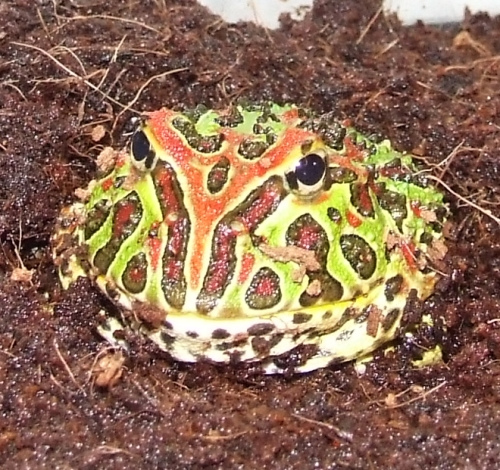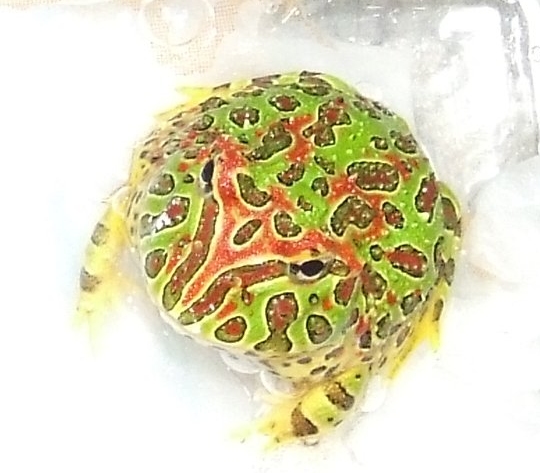|

Here is my care sheet for the Ornate Horned Frog, Cranwells Horned Frog, Pac-man Frog, Ceratophrys ornata, Ceratophrys
cranwelli.
Size
Males grow from 2 1/2"- 5" females get a bit larger from 3"-6", occasionally a specimen will grow larger than normal
or will stay smaller than normal as well.
Aggression
These frogs can be aggressive and will bite if they feel threatened, occasionally you will find a frog that refuses to
bite anything but it's food, I consider this a curse and a blessing, it's much easier to introduce new food items or prekilled
food items to your frog if it will readily attack.
Tank
A frog like this can be kept in a common 10 gallon aquarium all of it's life, although bigger is better it is generally
not needed since these are fairly inactive frogs. A lid is not needed but is preferred to keep anything out and to be used
to hold a small heat lamp up to warm their enclosure.
Heating
The best heating method for these frogs is to have a clamp lamp (sold at any local hardware store) with a standard ligt
bulb in it that will keep your enclosure between 70 and 85 degrees farenheight during the day, at night temperatures can drop
to the mid to low 60's without a problem. Heat mats and heat rocks are not a good choice because they can burn your frogs
because they burrow to escape the heat, which would make them burrow towards the heat.
Substrate
This has been a major topic amongst many hobbyists, but one of the best substrates is ground dehydrated coconut fiber,
commonly sold as "Eco Earth" and "Bed A Beast" when properly hydrated for your frogs it should feel damp to the touch, and
you should not see excess water. Do not use gravel because it is commonly known to cause impactions in these frogs. And do
not use any soils that have chemicals or fertilizers in them, these would include potting soil, because the chemicals in these
will kill your frogs rather quickly.
Water
These frogs will need a water bowl to rehydrate when they want, it should be at least as big around as the frog and only
as deep as it's top lip to keep the frog from drowning, because they are not great swimmers. You should use plain spring water
or dechlorinated/dechloramined tap water for your frogs water, because they are very sensitive to chemicals in the water.
Distilled and R/O water will hurt your frog by leeching out all the minerals in your frog, so do not use it.
Feeding
When young these frogs should be fed 3-4 small crickets every other day, this will constitute the size range of up to
1 1/2" or age range of about 3 months.
From about 3 months to 6 months or 1 1/2" to 2 1/2" they should be fed every 3 days 5-6 small crickets.
From 6 months to 1 year or from 2 1/2" to 3 1/2" they should be fed 6-8 medium sized crickets every 4-5 days.
From 1 year old on or 3 1/2" to 4 1/2" they should be fed 8-12 large crickets every 6- 7 days.
Remember these feeding schedules may not work for every frog, but they have worked for all of the Ceratophrys species
I have owned. All feeding schedules are adjustable. if your frogs begins to get fatter than a normal sized specimen feed them
less each feeding, if your frogs begins to appear skinny feed them a little more each feeding.
This schedule is designed so that the novice keeper can maintain their frogs and have a guide on how to feed it.
And remember these frogs will eat as much as you will feed them and will literally eat themselves to death.
Acceptable Foods
Here is a list of acceptable foods.
Crickets- These should be a staple of your frogs diet, but remember to gut load your crickets and dust them with a calcium
and vitamin suppliment at least 1/2 of your frogs feedings each week.
Earthworms and Nichtcrawlers- These are also another major food for your frogs diet, these should be washed off with
dechlorinated/dechloramined water before being fed to your frog as well as calcium and vitamin dusted before hand.
Feeder Fish- These are not suggested to be fed often since they can carry heavy loads of parasites, and are known to
block tyamanise in many animals. These should not be calcium and vitamin dusted before feeding or they may cause a calcium
overdose, since they are very high in calcium.
Mealworms and Kingworms- These are acceptable as an occasional treat and should be calcium and vitamin dusted as well
as gut loaded before being fed to your frog. Before feeding them to your frog be sure to crush their heads and poke a hole
in each of thier exo-skeletons to aid in it's digestion.
Waxworms- These can also be fed as an occasional treat, as a treat you don't need to worry about these being dusted provided
they are not the entire meal being offered to your frog at that feeding. Do not over feed these to your frog or it may become
obese and unhealthy due to a high fat content.
Adult Mice- When your frog is larger it may be able to eat an adult mouse, if you wish to do this, do not do it more
than once a month. The mouse should not be dusted, and should be a prekilled mouse so it does not harbor parasites and does
not wound your frog by biting it. These should not be fed frequently because mammilian fats are hard to digest for amphibians
and will cause obesity blindness and kidney damamge wich can kill your frog.
Pinky Mice- These are ok as an occasioal treat once a month, and should be dusted with a calcium vitamin suppliment.
These should not be fed frequently because mammilian fats are hard to digest for amphibians and will cause obesity blindness
and kidney damamge wich can kill your frog.
Breeding
Feed your horned frogs a big meal, about 4 days after this you lower the temperature to about 70 degrees and let the
substrate dry a bit then after they burrow lower it to about 65 degrees and make sure the substrate doesn't get too dry. Keep
that up for a month to 2 months and raise the temp back up and wet the substrate to more wet than usual, unbury them if they
haven't unburied themselves within a couple days and feed them a big meal and put them in a divided rain chamber until the
female get plump with eggs and the male is calling frequently to reactivae them, you can record the males calls to stimulate
his calling more, then once they're ready remove the divider and let them amplex and lay eggs. Be sure you have plenty of
food and water available for the tadpoles since they will need lots of food to prevent cannibalism and lot of clean water
to prevent them from dying from ammonia buildup, they will fully metamorphose in about a month, at which point you'll have
even more fun trying to keep them clean and fed since you will have to keep them separate or they will eat each other.

Rain Chamber
My rain chamber consisted of a 10 gallon aquarium with a power head pump on the bottom pushing water up out of the water
and letting it back about an in or two from the nozzle, you could also get constructive and connect a hose to the end of the
nozzle and poke many holes in the hose and cork the other end of it so it's a mist falling on your frogs constantly. I had
2, 10 gallon aquariums set up this way, one for the male and one for the female, just be sure you have a sloped area of land
so they don't drown, this can be gravel since they won't be eating in these tanks.
|

